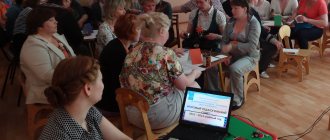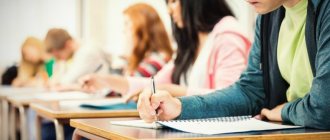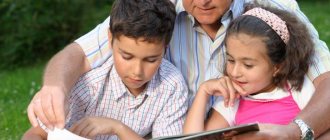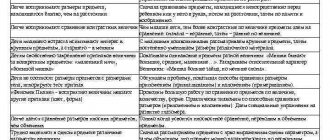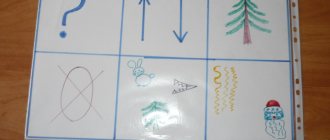Health-saving pedagogical technologiesmethodological development
Health-saving pedagogical technologies
This concept remains controversial; different authors have different interpretations of the concept of “health-saving pedagogical technologies”. The founder of the introduction of the concept of “health-saving educational technologies” into the practice of education is N.K. Smirnov, who argues that health-saving educational technologies can be considered as the technological basis of health-saving pedagogy, as a set of forms and methods of organizing the education of children without compromising their health, as qualitative characteristics of any educational technology based on the criterion of its impact on the health of the child and the teacher. The author writes that, as an adjective, the concept “health-saving” refers to a qualitative characteristic of any educational technology, showing to what extent the implementation of this technology solves the problem of preserving the health of the main subjects of the educational process - children and teachers; Health-saving technology can be considered as a “health safety certificate” and as a set of those principles, techniques, methods of pedagogical work that complement traditional technologies with health-saving tasks.
Health-saving pedagogical technologies include all aspects of the teacher’s influence on the child’s health at different levels - informational, psychological, bioenergetic.
1. organizational and pedagogical (determining the structure of the educational process, partially regulated in SanPiN, helping to prevent states of overfatigue, physical inactivity and other maladaptive states);
2. psychological and pedagogical (related to the impact that the teacher has on children; with psychological and pedagogical support of all elements of the educational process);
3. educational (including programs to teach how to take care of your health and create a culture of health, motivation to lead a healthy lifestyle, and prevent bad habits);
4. socially adapting and personal development (ensuring the formation and strengthening of the psychological adaptation of the individual);
5. therapeutic and recreational (therapeutic physical education and therapeutic pedagogy).
Any pedagogical technology must be health-saving; any influence on a preschool child must be based on the principle of health-saving. Health-saving technologies used in the practice of preschool education are technologies aimed at preserving, maintaining and enriching the health of the subjects of the educational process in preschool educational institutions: children, their parents and teachers. The goals of health-saving technologies in relation to a child are to ensure a high level of real health of the child and the formation of motivational attitudes towards a conscious attitude towards one’s health; in relation to adults - promoting the establishment of a culture of health, including a culture of professional health. Also, health-saving technologies are a system of measures that include the interrelation and interaction of all factors of the educational environment aimed at preserving the health of a child at all stages of his learning and development. The goal of health-saving technologies is to provide the child with the opportunity to maintain health, to develop in him the necessary knowledge, skills and habits for a healthy lifestyle.
In modern conditions, human development is impossible without building a system for the formation of his health. The choice of health-saving pedagogical technologies depends on the type of preschool institution, the length of stay of children in it, the program under which teachers work, the specific conditions of the preschool educational institution, the professional competence of the teacher, as well as children’s health indicators.
1 medical and preventive (ensuring the preservation and enhancement of children’s health under the guidance of medical personnel in accordance with medical requirements and standards, using medical supplies - technologies for organizing monitoring of the health of preschool children, monitoring children’s nutrition, preventive measures, a health-preserving environment in preschool educational institutions);
2. physical education and health (aimed at the physical development and strengthening of the child’s health - technologies for the development of physical qualities, hardening, breathing exercises, etc.);
3. educational (nurturing a culture of health in preschool children, person-centered education and training);
4. ensuring the socio-psychological well-being of the child (ensuring the mental and social health of the child and aimed at ensuring the emotional comfort and positive psychological well-being of the child in the process of communicating with peers and adults in kindergarten and family; technologies for psychological and pedagogical support of the child’s development in the pedagogical process of the preschool educational institution );
5. health conservation and health enrichment for teachers (aimed at developing a culture of health for teachers, including a culture of professional health, and developing the need for a healthy lifestyle); maintaining and stimulating health (technology of using outdoor and sports games, gymnastics (for the eyes, breathing, etc.), stretching, rhythmoplasty, dynamic pauses, relaxation);
6. teaching a healthy lifestyle (technologies for using physical education classes, communicative games, a system of classes from the “Health Lessons” series, problem-based games (game training, game therapy), self-massage); correctional (art therapy, music technology, fairy tale therapy, psycho-gymnastics, etc.)
7. Health-saving pedagogical technologies include the pedagogical technology of an active sensory-developmental environment, which is understood as a systemic set and order of functioning of all personal instrumental and methodological means used to achieve pedagogical goals. The essence of this technology lies not so much in modeling the educational space within the framework of an active sensory-developmental environment, but in the system of relationships between the teacher and children: the core of an active sensory-developmental environment is not a system of sensory didactics, nor a complex of working modes, but rather a system of subject-subject relations between teacher and student.
And it is this system that acts as the condition, means and result of the child’s formation as a subject of further development.
1. use of a desktop desk (working in the mode of changing dynamic poses), a landscape panel (situational-figurative modeling),
2. ophthalmic simulators (performing visual training),
3. visual material on a sensory-didactic suspension,
4. sensory-didactic holder (switching children’s vision from near to distant targets), etc.
Let's look at each of them.
- The secret of kindness is to give kindness to children, so that they themselves begin to give kindness to others.
- The secret of success (in business and in life in general) is the desire and willingness to give joy to yourself and others, in order to be able to always find reasons for joy, no matter how difficult life is.
- The secret to the effectiveness of efforts to create a health-preserving space is the professionalism of all teachers working in an educational institution.
- The secret of effectiveness is the purposeful cultivation of a culture of children’s health, the ability and ability to take care of their own health.
- The secret to ensuring that what is created corresponds to what was planned is objective tracking of the results obtained
- The secret of manufacturability is the creation of a working technology from the sum of disparate programs, techniques, and techniques is possible only if there is a unity of goals, objectives, principles and methodologies.
- The secret of truth is an intuitive feeling of the consistency of what is being done.
You can also define the basic principles (ideas) of health-saving technologies:
1. humanization - the priority of the personal, individual development of the child in the organization of the pedagogical process of the preschool educational institution;
2. taking into account the age and individual characteristics of the child - the use of primary diagnostics of healthy children, taking into account its results and the main neoplasms! age during the organization of a health-saving pedagogical process;
3. taking into account and developing the subjective qualities and properties of the child - observing in the organization of the pedagogical process the interests and focus of the child on specific types of activities, maintaining his activity, independence, initiative;
4. subject-subject interaction in the pedagogical process - freedom of expression and behavior in different forms of organization of the pedagogical process; during such interaction, the child can choose types of children's activities in which he could realize his maximum potential;
5. pedagogical support - solving a difficult situation together with the child using methods and techniques acceptable for a particular child, the main criterion for the implementation of this principle is the child’s satisfaction with the activity itself and its results, relieving emotional tension;
6. professional cooperation and co-creation - professional interaction between educators and specialists in the process of organizing a health-saving pedagogical process.
Health-saving technologies
| Concept | Definition |
| "technology" | is, first of all, a systematic method of creating, applying and defining the entire process of teaching and acquiring knowledge, taking into account technical and human resources and their interaction, which aims to optimize the forms of education. |
| "pedagogical technology" | - strictly scientific forecasting (design) and accurate reproduction of pedagogical actions that ensure the achievement of planned results. |
| “educational technology of health preservation pedagogy” | is the process of reproducing pedagogical actions from the arsenal of pedagogical and methodological tools within the framework of the “teacher-student” connection, carried out through the systematic use of forms, means and methods that ensure the achievement of planned results, taking into account the goals and objectives of health conservation pedagogy. |
| "health-saving technology" | - this is a system of measures that includes the interrelation and interaction of all factors of the educational environment aimed at preserving the health of the child at all stages of his education and development. The concept of preschool education provides for not only the preservation, but also the active formation of a healthy lifestyle and the health of pupils. |
| "health" | is a state of complete physical, mental and social well-being and not merely the absence of disease or infirmity. |
| "physical health" | - this is the perfection of self-regulation in the body, maximum adaptation to the environment. |
| "physical activity" | - the natural need of a healthy, developing organism to move (in childhood it acts as a prerequisite for the child’s mental development). |
| "mental health" | - this is a high consciousness, developed thinking, great internal and moral strength that encourages creative activity. |
| "mental activity" | — the need of a normally developing child for knowledge of the surrounding life: nature, human relationships; in knowing yourself. |
| "social health" | - this is moral self-control, an adequate assessment of one’s “I”, self-determination of the individual in optimal conditions of the micro- and macroenvironment (family, school, social group). |
| "social activity" | - manifests itself in behavior aimed at maintaining and following rules, in an effort to help their peers follow these rules. |
| "moral health" | - this is a complex of characteristics of the motivational and need-information sphere of life, the basis of which is determined by the system of values, attitudes and motives for the behavior of an individual in society. Moral health is mediated by human spirituality, as it is connected with the universal truths of goodness, love, mercy and beauty. |
Modern health-saving technologies
| Types of health-saving pedagogical technologies | Time spent in the daily routine | Features of the methodology | Responsible |
| 1. technologies for preserving and promoting health | |||
| Stretching | Not earlier than in 30 minutes. after meals, 2 times a week for 30 minutes. from middle age in physical education or music halls or in a group room, in a well-ventilated area | Recommended for children with sluggish posture and flat feet. Beware of disproportionate load on muscles | Head of Physical Education |
| Rhythmoplasty | Not earlier than in 30 minutes. after meals, 2 times a week for 30 minutes. from middle age | Pay attention to the artistic value, the amount of physical activity and its proportionality to the age of the child | Musical director. |
| Dynamic pauses | During classes, 2-5 minutes, as children get tired | Recommended for all children as a preventive measure against fatigue. May include elements of eye exercises, breathing exercises and others, depending on the type of activity | Educators |
| Outdoor and sports games | As part of a physical education class, on a walk, in a group room - small with an average degree of mobility. Daily for all age groups | Games are selected according to the age of the child, the place and time of the game. In preschool educational institutions we use only elements of sports games | Educators |
| Relaxation | In any suitable room. Depending on the condition of the children and goals, the teacher determines the intensity of the technology. For all age groups | You can use calm classical music (Tchaikovsky, Rachmaninov), sounds of nature | Teachers, psychologist |
| Aesthetic technologies | Implemented in classes in the artistic and aesthetic cycle, when visiting museums, theaters, exhibitions, etc., decorating premises for holidays, etc. for all age groups | It is carried out in classes according to the preschool education program, as well as according to a specially planned schedule of events. Of particular importance is working with families, instilling in children an aesthetic taste | All preschool teachers |
| Finger gymnastics | From a young age, individually or with a subgroup daily; | Recommended for all children, especially those with speech problems. Conducted at any convenient time (at any convenient time) | Educators, speech therapist, psychologist |
| Gymnastics for the eyes | Every day for 3-5 minutes. at any free time; depending on the intensity of visual load from a young age | It is recommended to use visual material, demonstration by the teacher | All teachers |
| Breathing exercises | In various forms of physical education and recreational work | Ensure the room is ventilated and the teacher give children instructions on mandatory nasal hygiene before the procedure. | All teachers |
| Invigorating gymnastics | Every day after nap, 5-10 min. | The form of implementation is different: exercises on beds, extensive washing; walking on ribbed planks; easy running from the bedroom to a group with a difference in temperature in the rooms and others depending on the conditions of the preschool educational institution | Educators |
| Corrective gymnastics | In various forms of physical education and recreational work | The form of implementation depends on the task and the number of children | Teachers, head of physical education |
| Orthopedic gymnastics | In various forms of physical education and recreational work | Recommended for children with flat feet and as a prevention of diseases of the supporting arch of the foot | Teachers, head of physical education |
| 2. Technologies for teaching a healthy lifestyle | |||
| Physical education lesson | 2-3 times a week in a sports or music hall. early age - in a group room, 10 min. younger age - 15-20 minutes, middle age - 20-25 minutes, older age - 25-30 minutes. | Classes are conducted in accordance with the program according to which the preschool educational institution operates. Before class, it is necessary to ventilate the room well | Teachers, head of physical education |
| Problem-based games (game training and game therapy) | In your free time, maybe in the second half of the day. time is not strictly fixed, depending on the tasks set by the teacher. | The lesson can be organized unnoticed by the child, by including the teacher in the process of play activity | Teachers, psychologist |
| Communication games | 1-2 times a week for 30 minutes. from an older age | Classes are structured according to a certain scheme and consist of several parts. They include conversations, sketches and games of varying degrees of mobility, drawing, modeling, etc. | Teachers, psychologist |
| Lessons from the “health” series | Once a week for 30 minutes. from Art. age | Can be included in the lesson schedule as cognitive development | Teachers, head of physical education |
| Self-massage | Depending on the goals set by the teacher, sessions or in various forms of physical education and recreational work | It is necessary to explain to the child the seriousness of the procedure and give children basic knowledge on how not to harm their body | Educators, Art. nurse, head of physical education |
| Acupressure self-massage | Conducted on the eve of epidemics, in the autumn and spring periods at any time convenient for the teacher from an older age | It is carried out strictly according to a special technique. Indicated for children with frequent colds and diseases of the ENT organs. Visual material is used | Educators, Art. nurse, head of physical education |
| Biofeedback (boss) | From 10 to 15 sessions of working with a computer for 5-10 minutes. in a special room. Recommended for older adults | It is necessary to comply with the rules of working on a computer. a special technique is recommended for pre-school children | Specially trained teacher |
| 3. Corrective technologies | |||
| Art therapy | Sessions of 10-12 lessons for 30-35 minutes. from middle group | Classes are conducted in subgroups of 10-13 people, the program has diagnostic tools and presupposes training protocols | Teachers, psychologist |
| Music influence technologies | In various forms of physical education and recreational work; or separate classes 2-4 times a month, depending on your goals | Used as an aid as part of other technologies; to relieve stress, increase emotional mood, etc. | All teachers |
| Fairy tale therapy | 2-4 lessons per month for 30 minutes. from an older age | Classes are used for psychological therapeutic and developmental work. A fairy tale can be told by an adult, or it can be a group story, where the narrator is not one person, but a group of children | Teachers, psychologist |
| Color influence technologies | As a special lesson 2-4 times a month depending on the assigned tasks | It is necessary to pay special attention to the color scheme of the interiors of preschool educational institutions. Properly selected colors relieve tension and increase the child’s emotional mood | Teachers, psychologist |
| Behavior correction technologies | Sessions of 10-12 lessons for 25-30 minutes. from an older age | They are conducted using special methods in small groups of 6-8 people. Groups are not formed according to one criterion - children with different problems study in the same group. Classes are conducted in a game form, have diagnostic tools and training protocols | Teachers, psychologist |
| Psycho-gymnastics | 1-2 times a week from older age for 25-30 minutes. | Classes are conducted using special methods | Teachers, psychologist |
| Phonetic rhythm | 2 times a week from a young age, no earlier than every 30 minutes. after meals, in physical education or music halls. ml. age - 15 min., older age - 30 min. | Classes are recommended for children with hearing problems or for preventive purposes. The goal of the classes is phonetic literate speech without movements | Teachers, head of physical education, speech therapist |
